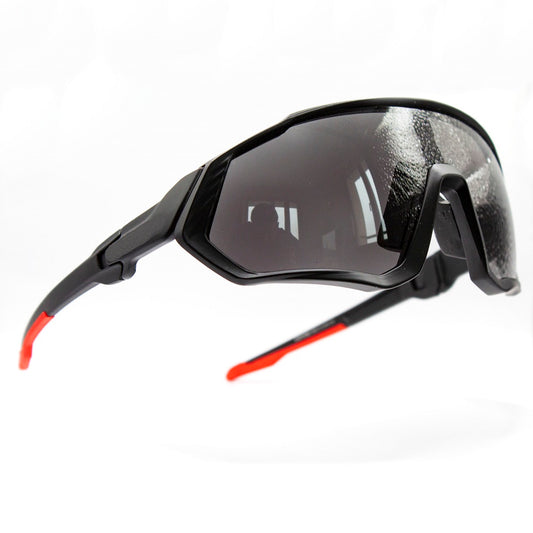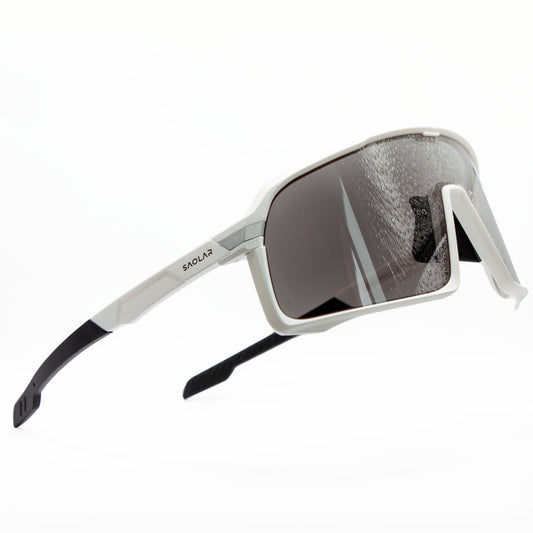Whether you're an experienced rider or a newbie cyclist, selecting the right eyewear is a crucial part of your cycling gear. The options for sports eyewear can seem endless, and the choice can be daunting. In this article, we'll focus on one particular debate: Photochromic Lenses vs Polarized Sunglasses.
While both have their unique features and benefits, we're going to delve into the pros and cons of polarized sunglasses vs photochromic lenses to how they fare in the world of cycling.
We'll discuss the disadvantages of polarized cycling sunglasses, and answer the question, "are polarized lenses good for cycling?". Key aspects such as UV protection and polarization will be examined to understand how they contribute to safety and performance. We'll also compare photochromic cycling glasses to polarized lenses, helping you understand the difference and the potential impact on your cycling experience.
Whether you're a beginner wondering if polarized lenses are good for cycling, or a seasoned cyclist considering photochromic lenses, this comprehensive guide is for you.
So, join us as we navigate through this comparison of photochromic lenses vs polarized, shedding light on the pros and cons of each, and ultimately demonstrating why photochromic lenses could be the better choice for your cycling adventures.

While most people have only heard of polarized, photochromic sunglasses offer a unique set of benefits. Before diving into the comparison of photochromic lenses vs polarized, let's first understand the basics of these two types of eyewear. Understanding their unique properties and functionalities will provide a solid foundation for the rest of our discussion.
What are Photochromic Cycling Glasses?
Photochromic cycling glasses, also known as transition lenses, are a type of eyewear that dynamically adapts to changing light conditions. The lenses are virtually clear in low light or indoor conditions and darken automatically when exposed to sunlight, offering optimal contrast in different settings. This technology relies on UV light for activation, ensuring your eyes are protected from harmful rays while also enhancing vision clarity, regardless of the lighting conditions.
What are Polarized Cycling Sunglasses?
Polarized cycling sunglasses, on the other hand, are specifically designed to reduce glare from surfaces like water, snow, glass, pavement, and other common elements encountered on the road. This glare, often a form of horizontal light, can be particularly intense and distracting during cycling. These lenses contain a special filter that blocks the intense reflected light, reducing strain on your eyes and helping you see more clearly while wearing them.
While they offer clear vision on sunny days, one of the main disadvantages of polarized cycling sunglasses is their performance in varying light conditions. Unlike photochromic lenses, polarized sunglasses maintain the same level of darkness regardless of the ambient light.
What is the Difference between Polarized vs Transition Lenses?
The key distinction between polarized lenses vs transition lenses centers on their ability to adapt to varying light conditions. Transition lenses, also known as photochromic lenses, adjust their level of tint based on the intensity of UV light. On the other hand, polarized lenses maintain a constant level of tint, regardless of the light conditions.
In terms of glare reduction, polarized lenses stand out in the transition vs polarized lenses comparison by reducing the glare from reflective surfaces. However, photochromic lenses offer the convenience of not having to switch glasses as lighting conditions change, which can be a significant advantage for cyclists.
Stay tuned as we delve into more details about the pros and cons of transition lenses vs polarized sunglasses and why photochromic (transition) lenses could be a better choice for cyclists in the following sections.
Photochromic Lenses vs Polarized: The Trade-Offs

Now that we've laid the groundwork by explaining the basics of both types of lenses, let's dig deeper into their individual strengths and weaknesses. We'll analyze the pros and cons of polarized sunglasses and pit them against photochromic cycling glasses.
Pros and Cons of Polarized Sunglasses
Polarized cycling sunglasses are renowned for their ability to minimize glare. This makes them an excellent choice for cycling on sunny days, especially when you're riding near water or shiny surfaces that reflect sunlight. They can improve clarity and reduce eye strain, making your rides more comfortable.
However, the disadvantages of polarized cycling sunglasses become apparent when conditions are not optimal. They can distort your perception of depth, and the dark tint can make it difficult to see clearly in low-light conditions or when you move through areas of shade on your cycling route. Additionally, certain LCD displays, like the ones on some bike computers or smartphones, can appear blacked out due to the polarizing filter.
Photochromic vs Polarized Sunglasses for Cycling
Photochromic lenses, on the other hand, provide a versatile solution for cyclists. Their ability to adjust to changing light conditions makes them ideal for long rides that span from day to night, or for routes that include a variety of environments such as open roads, shaded areas, and tunnels.
While they might not eliminate glare as effectively as polarized lenses, their adaptive nature means that they can provide adequate visibility in a wider range of conditions. Additionally, they don't suffer from the same issues with LCD displays that you encounter with polarized lenses.
In the next section, we'll delve into the discussion of whether polarized lenses are good for cycling, particularly for beginners, and whether they're a good choice for men's cycling sunglasses. We'll also make a case for why photochromic lenses might be the superior choice.
Polarized Sunglasses: Are They Really Good for Cycling?

We've outlined the basic characteristics of polarized vs photochromic lenses and highlighted their strengths and weaknesses. Now, let's explore more deeply if polarized lenses are good for cycling. This section will consider different scenarios, including beginner cyclists and male cyclists.
Are Polarized Lenses Good for Cycling?
Polarized lenses offer excellent glare reduction, making them suitable for certain cycling conditions. If you're cycling in bright, sunny environments with high glare, such as near bodies of water or shiny, reflective surfaces, polarized lenses can be beneficial. They reduce eye strain and provide better visibility in these specific conditions.
However, the key disadvantages of polarized cycling sunglasses come into play in less-than-ideal conditions. The constant dark tint can obscure vision in low-light conditions or shaded areas. They can also make it difficult to read LCD displays on cycling computers or smartphones, which can be inconvenient during a ride.
Polarized Lenses Good for Cycling for Beginners?
For beginners, choosing the right eyewear can significantly impact their cycling experience. While polarized lenses might seem appealing due to their glare-reducing properties, their disadvantages make them less than ideal for beginners. The potential distortions in depth perception and difficulty seeing in varying light conditions can prove challenging for those new to the sport.
Polarized Sunglasses for Cycling for Men
When considering polarized sunglasses for cycling for men, the decision largely depends on the specific needs and riding conditions of the cyclist. If the majority of your cycling occurs in bright, high-glare environments, polarized sunglasses can be beneficial. However, if your rides take you through varying light conditions, photochromic lenses may be a more versatile choice.
We will further discuss why photochromic cycling glasses can be a superior choice when considering the trade-offs between photochromic lenses vs polarized sunglasses for cycling.
A Case for Photochromic Cycling Glasses
Having weighed the pros and cons of both polarized and photochromic lenses, it's time to examine why photochromic cycling glasses might be a better choice for your cycling endeavors. This section aims to further illustrate the superiority of photochromic lenses over polarized lenses in most cycling conditions.
Why Photochromic Cycling Glasses are a Better Choice
Photochromic lenses provide a level of versatility that polarized lenses lack. Their ability to adjust to varying light conditions makes them perfect for cycling at different times of the day or through changing environments. Whether you're cycling under the bright afternoon sun or in the dim light of early dawn, photochromic lenses ensure that you have optimal vision.
In comparison to the disadvantages of polarized cycling sunglasses, photochromic lenses offer a more balanced performance. They don't obscure LCD displays, making it easier for you to check your stats on your cycling computer or smartphone during a ride.
Photochromic vs Polarized Sunglasses for Cycling
When directly comparing photochromic vs polarized sunglasses for cycling, the former's adaptability gives it an edge. While polarized lenses might provide better glare reduction in bright light, their performance drops in less-than-ideal light conditions. On the other hand, photochromic lenses offer good performance across a range of light conditions, making them a more reliable choice for cyclists.
Polarized vs Photo Polarized Sunglasses
An emerging technology in eyewear is photo polarized sunglasses, which combine the advantages of both photochromic and polarized lenses. These lenses adjust their tint based on light conditions like photochromic lenses while also reducing glare like polarized lenses. However, they might not be as widely available or budget-friendly as standard photochromic or polarized lenses.
While polarized lenses have their strengths, the versatility and reliability of photochromic lenses make them a superior choice for most cyclists. This isn't a one-size-fits-all solution, but a general recommendation based on the performance of both types of lenses in a variety of cycling conditions.
Deciphering the Best Choice - Photochromic vs Polarized Lenses for Cycling

Choosing the right eyewear for cycling is a critical decision that can significantly impact your cycling experience. Throughout this guide, we've delved into the strengths and weaknesses of both photochromic and polarized lenses. We've explored the pros and cons of polarized sunglasses and how they stand up against photochromic cycling glasses.
We've discovered that while polarized lenses can be effective in bright, high-glare conditions, they fall short in varying light environments and can distort LCD screens. On the other hand, photochromic lenses adapt to changing light conditions, providing optimal vision whether you're cycling under a glaring sun or through a shadowed trail.
Our analysis shows that photochromic lenses vs polarized, the former provides a more versatile and balanced performance for cyclists. While polarized lenses can be a good choice for specific conditions, the adaptability of photochromic lenses makes them a more reliable option for cycling in a variety of environments and lighting conditions.
Ultimately, your choice will depend on your specific needs, riding conditions, and personal preferences. However, based on our comparison, it's clear that for most cyclists, photochromic lenses can offer a more convenient and adaptive solution for their cycling adventures.
We hope this comprehensive guide about photochromic lenses vs polarized has given you valuable insights to help you make an informed decision about your cycling eyewear. Remember, the right choice depends on your individual needs, your cycling environment, and your personal preferences.
If you're considering investing in a new pair of photochromic cycling glasses, take the time to explore different models. Research, read reviews, and seek expert advice to ensure you're getting the best glasses for your specific needs.
And remember, while we have discussed the disadvantages of polarized cycling sunglasses, they may still be the right choice for some cyclists, particularly those riding predominantly in high-glare environments.
Are you ready to take your cycling experience to the next level? Check out our range of high-quality cycling glasses today. Whether you're looking for the versatility of photochromic lenses or the glare reduction of polarized lenses, we've got you covered.
Never compromise on your vision while cycling. Choose the right eyewear and enjoy your ride!








